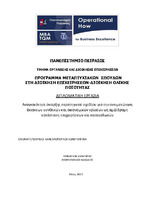Αναγκαιότητα ύπαρξης στρατηγικού σχεδίου για την αντιμετώπιση έκτακτων συνθηκών και οικονομικών κρίσεων ως αμφίδρομη κατάσταση επιχειρήσεων και καταναλωτών
Necessity of having a strategic plan to deal with emergency situations and financial crises as a two-way situation for businesses and consumers

View/
Abstract
The internal sources of competitive advantage span a vast array of domains. An organization's significant competitive advantages are not solely determined by external circumstances. An organization's internal sources of competitive advantage are regarded as essential success elements. The research examines the vast literature of competitive advantage. The notions of competitive advantages through correct management action in managing an organization's structure, process, culture, and people were used to show the emergence of major theories in the literature review. Consequently, the objective of competitive advantage recognition is to link the organization's resources, capabilities, and core competencies.
Total quality management (TQM) has been one of the most widely used management acronyms since the 1980s. As a change management tool, TQM has been well-received by managers because it is viewed as providing a " set of principles that can guide them through numerous options or even make selection unnecessary" (Huczynski, 1993, Management Gurus: What Makes Them and How to Become One (London, Routledge), p. 289). Despite the fact that the management of quality has been identified as a crucial to company success in the highly competitive 1990s, TQM is not without its detractors.
Focus of quality specialists should be on enhancing performance via enhanced processes. Based on the IPO (Input-Process-Output) model, this study considers total quality management (TQM) as an input of an organization's internal and external, and transformational leadership (TL) and executive ability (EA) as the mechanism (Process) to promote and coordinate internal–external elements for the organization to achieve its sustainable competitive advantage (SCA) (Output).
Given the disruptions resulting from the Covid-119 pandemic as well as the advancement of the global technological environment towards the fourth industrial revolution, there is a need to explore the future of human resource management. Based on the research findings, seven distinct themes have emerged, each with the potential to significantly influence HRM practices and, therefore, the future competitiveness of organizations. These topics include the primacy of human resource management (HRM), increased cyber influences, digitalization, remote HRM, human-machine interface skills, strategic linkages between people and organizations, and human-technology interface capabilities. According to the research findings, the study suggested that HRM departments should transition to HR 4.0 by adopting Industry 4.0 technologies, increasing automation and digitalization, and enhancing virtualization systems.
This study examines the impact of Total Quality Management (TQM) methods on organizational performance and competitive advantage. This study design is quantitative in nature. The data was acquired via a questionnaire. The units of analysis are large and medium-sized fisheries. This study's respondents are the managers of fishing firms. The research employed primary data collected by questionnaire. Indonesia's South Sulawesi Province had a population of 66 fishing enterprises. The study employs random sampling. 55 full surveys were returned as a final sample. After a survey of the literature, three hypotheses have been developed and tested using Path Analysis in SPSS 18.00. The findings demonstrate that TQM techniques have a favorable and considerable impact on both organizational performance and competitive advantage. Competitive advantage has a favorable and significant impact on the success of a business. Competitive advantage influences organizational performance more than TQM procedures.


